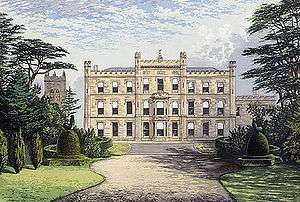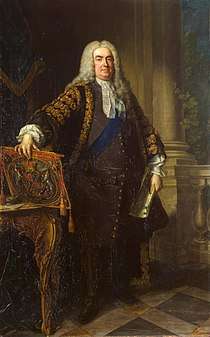William Stanhope, 1st Earl of Harrington
William Stanhope, 1st Earl of Harrington, PC (c. 1683 – 8 December 1756) was a British statesman and diplomat.
The Earl of Harrington PC | |
|---|---|
%2C_Attributed_to_Godfrey_Kneller.jpg) William Stanhope, 1st Earl of Harrington (Godfrey Kneller, 1646–1723) | |
| Lord Lieutenant of Ireland | |
| In office 15 November 1746 – 15 December 1750 | |
| Monarch | George II |
| Preceded by | The Earl of Chesterfield |
| Succeeded by | The Duke of Dorset |
| Lord President of the Council | |
| In office 13 February 1742 – 3 January 1745 | |
| Monarch | George II |
| Prime Minister | The Earl of Wilmington Henry Pelham |
| Preceded by | The Earl of Wilmington |
| Succeeded by | The Duke of Dorset |
| Personal details | |
| Born | William Stanhope c. 1683 Elvaston, Derbyshire |
| Died | 8 December 1756 London, England. |
| Nationality | British |
| Spouse(s) | Anne Griffith |
| Parents | John Stanhope Dorothy Agard |
| Residence | Elvaston Castle |
Life

William Stanhope was born in 1683 at the family home in Elvaston, Derbyshire, third surviving son of John Stanhope and Dorothy Agard. His elder brother Charles Stanhope (1673–1760) was also a politician and deeply involved in the South Sea Company financial scandal, while his cousin James Stanhope (1673–1721) is considered an alternative candidate to Robert Walpole for the title of Britain's first Prime Minister.[1]
He married Anne Griffiths, who died in 1719 giving birth to twin sons, William, 2nd Earl of Harrington (1719–1779) and Thomas (1719–1743).
Career
Educated at Eton College, Stanhope was commissioned in 1703 as a Lieutenant in the 2nd Foot Guards during the War of the Spanish Succession, before transferring to the 3rd Foot Guards in Spain. By 1710, he was a Lieutenant-Colonel and missed the December 1710 Battle of Brihuega, when the British rearguard under his cousin James Stanhope was cut off and forced to surrender. In March 1711, he became Colonel of the former Lepells Regiment, which was disbanded in November 1712 as the army was cut back in the run-up to the 1713 Peace of Utrecht.[2]
Stanhope was serving as a diplomat in Spain when the War of the Quadruple Alliance began in 1719 and joined the French army under the Duke of Berwick as a volunteer.[3] When the war ended in 1720, Stanhope was appointed British ambassador to Spain and given the Colonelcy of the 13th Light Dragoons, later 13th Hussars; he retained this position until the Anglo-Spanish War began in March 1727, having built up his reputation as a diplomatist during a difficult period.[4]

As a reward for his part in negotiating the 1729 Treaty of Seville that ended the war, he was created Baron Harrington in January 1730. Later the same year, he replaced Lord Townshend as Secretary of State for the Northern Department under Robert Walpole. Despite policy differences over British involvement in the 1734–1735 war, he kept his position until Walpole's fall in 1742, when he became Lord President of the Council and created Earl of Harrington and Viscount Petersham.[4]
With the support of his political ally the Duke of Newcastle, he was restored as Secretary of State in 1744 but resigned in February 1746 over his preference for an immediate end to the 1740–1748 War of the Austrian Succession. He was made Lord Lieutenant of Ireland from 1747 to 1751[4] and while his active military career finished in 1720, he received a number of promotions, ending a full General in 1747.[5] He died in London on 8 December 1756.

References
- Pearce, William (2007). The Great Man: Sir Robert Walpole: Scoundrel, Genius and Britain's First Prime Minister. Jonathan Cape. p. 1. ISBN 978-0224071819.
- Adjutant General's Office (1842). Historical Records of the British Army; History of the 13th Light Dragoons. John W Parker. p. 84.
- Adjutant General's Office, p. 84
-

- Woodfine, Philip (2004). "Stanhope, William, first earl of Harrington". doi:10.1093/ref:odnb/26257. Cite journal requires
|journal=(help)
Sources
- Adjutant General's Office (1842). Historical Records of the British Army; History of the 13th Light Dragoons. John W Parker.
- Pearce, William (2007). The Great Man: Sir Robert Walpole: Scoundrel, Genius and Britain's First Prime Minister. Jonathan Cape. ISBN 978-0224071819.
- Woodfine, Philip (2004). "Stanhope, William, first earl of Harrington". doi:10.1093/ref:odnb/26257. Cite journal requires
|journal=(help)
| Parliament of Great Britain | ||
|---|---|---|
| Preceded by Edward Mundy Nathaniel Curzon |
Member of Parliament for Derby 1715–1722 With: Lord James Cavendish |
Succeeded by Lord James Cavendish Thomas Bayley |
| Preceded by John Gumley Marquess of Carnarvon |
Member of Parliament for Steyning 1727 With: John Gumley |
Succeeded by The Viscount Vane Thomas Bladen |
| Preceded by Lord James Cavendish Thomas Bayley |
Member of Parliament for Derby 1727–1730 With: Lord James Cavendish |
Succeeded by Lord James Cavendish Charles Stanhope |
| Military offices | ||
| Preceded by Sir Robert Rich |
Colonel of Harrington's Regiment of Dragoons 1725–1730 |
Succeeded by Henry Hawley |
| Diplomatic posts | ||
| Vacant Title last held by John Chetwynd |
British Ambassador to Spain 1721–1727 |
Succeeded by Benjamin Keene |
| Political offices | ||
| Preceded by Thomas Coke |
Vice-Chamberlain of the Household 1727–1730 |
Succeeded by Lord Hervey |
| Preceded by The Duke of Devonshire |
Northern Secretary 1730–1742 |
Succeeded by The Lord Carteret |
| Preceded by The Earl of Wilmington |
Lord President of the Council 1742–1745 |
Succeeded by The Duke of Dorset |
| Preceded by The Lord Carteret |
Northern Secretary 1744–1746 |
Succeeded by The Earl of Chesterfield |
| Preceded by The Earl of Chesterfield |
Lord Lieutenant of Ireland 1746–1751 |
Succeeded by The Duke of Dorset |
| Peerage of Great Britain | ||
| New creation | Earl of Harrington 1742–1756 |
Succeeded by William Stanhope |
| Baron Harrington 1730–1756 | ||
